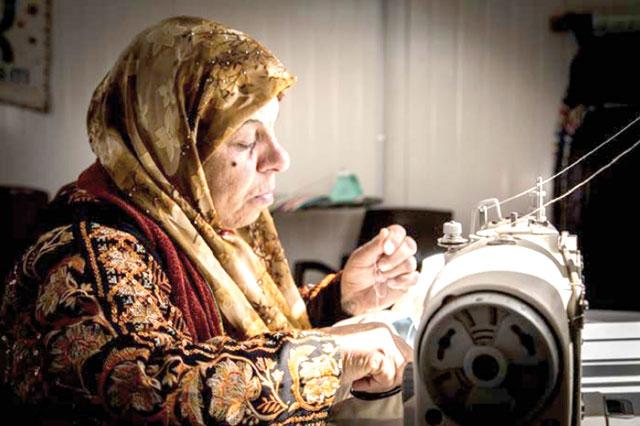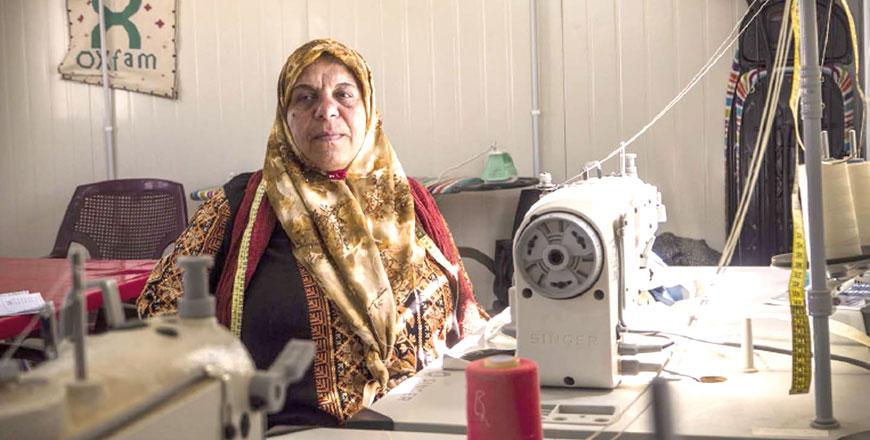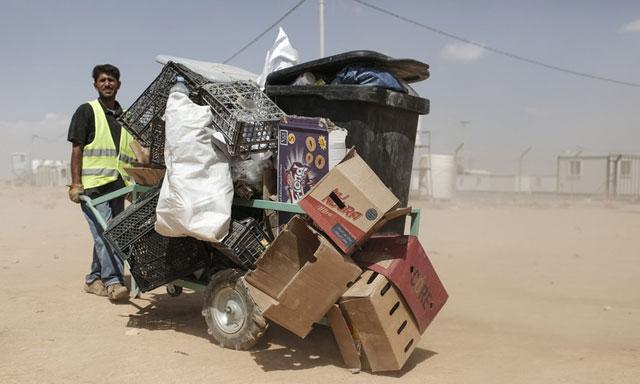You are here
Syrian refugee women find their way to Jordanian economy
By Camille Dupire - Aug 09,2018 - Last updated at Aug 09,2018

Some 280 women received professional seamstress training in Zaatari camp since April 2017 (Photo courtesy of Nesma Alnsour/Oxfam)
AMMAN — With some 5,000 cash-for-work positions available for nearly 80,000 Syrian refugees living in Zataari camp, the competition for work opportunities is often fierce, with the priority mostly given to men, as recent UNHCR data showed that only one-third of the cash-for-work positions are filled by women.
Limited opportunities for female refugees
In the northern Jordan camp, where half the residents are women and girls, 42 per cent of the population is of working age, the refugee agency added.
Aiming to reverse that trend, a vocational and soft skills training project was established by international NGO Oxfam in April 2017, helping Syrian refugee women enhance their employability and increase their self reliance.
“When we started our cash-for-work programmes in Zaatari, our teams initially had difficulties in attracting women,” a report quoted an Oxfam staff member as saying, adding “when our staff approached them to find out more about their reluctance to join, they learned that the women did not find the work opportunities appropriate for them and were also uncomfortable in workspaces with men.”
The Lel-Haya (“For Life” in Arabic) project, provided 280 women with professional seamstress training, where they learned how to produce fashionable tote bags from old UNHCR tents.
This caught the eye of the International Labour Organisation (ILO) and UNHCR, which facilitated the coordination between the Zaatari Office for Employment and a garment factory based in Irbid, with the aim of offering Zaatari women formal jobs in the factory.
“Contrary to the short-term jobs offered by humanitarian organisations, this employment programme aimed to promote formal, long-term work that would enhance women’s self-reliance,” a report by the NGO noted, adding that, despite initial reluctances due to the factory’s distance from the camp and preconceptions about its poor working environment, among many other reasons, some 25 women reached out for the opportunity.
A window into a new life
“It’s my first time leaving the house, honestly… It’s a nice feeling,” Amina, 29, told an Oxfam staff after she started working at the factor, echoing 20-year-old Sawsan’s comments. “I like leaving the camp… Zaatari is so dusty,” the young woman said.
Due to the restrictions put on Zaatari residents’ movement outside the camp, the daily commute to Irbid appeared like “a breath of fresh air” for these young women, who also enjoyed new social interactions.
“There’s a lot of work, but it’s nice to be with other people,” said Mariam, a 26-year-old Syrian, stressing “you’re under pressure, so you work together and cooperate.”
She said working at the factory gave her the opportunity to make new friends, both Syrians and Jordanians.
“The bonds these women form tend to make their experiences at the factory more than just a job — it became an opportunity to leave their homes and meet new people,” the Oxfam report said.
“Learning to sew is an investment for the future. The factory [job] won’t be around forever, but I can always use sewing around my house, for my kids, maybe even make some money from sewing on my own,” Sawsan continued.
“They understand that gaining and perfecting these skills will not only help them to advance in the workplace, but can benefit them in all aspects of their lives,” the Oxfam report continued, stressing that being enrolled in the formal workforce also allows these women to become eligible for benefits they would not receive in an informal work setting.
Currently pregnant, Sawsan can expect to be granted 70 days of paid maternity leave from the factory, as stipulated by Jordanian labour law. She said she is also given lighter tasks lately, as the variety of jobs at the garment factory allows for such flexibility
“They pay attention to these things and have been taking care of me. They say that my workload should stay light and that I shouldn’t work too hard,” she highlighted.
Complicated trade-off
However, working outside the camp also entails long working days and difficult commutes, which can be seen as a burden after a while, Oxfam Country Director Nivedita Monga noted, saying “these women leave their homes in Zataari in the early hours to get on the bus to work at a garment factory in Irbid. They return in the evening to fulfill their responsibilities at home, exactly like thousands of Jordanian women who work long hours both inside and outside their homes. There’s only so many hours in the day, so we need to think about how we can support women with work options that do not overburden them.”
“The bus route keeps getting longer and more tiring. My parents are starting to get upset about this and I think they might start to take issue with the lateness,” Mariam said, noting that the extended bus journeys to the factory sometimes cause her issues as late returns are only seen as acceptable for male family members.
In remarks to The Jordan Times, Monga stressed the need for a diversity of work options to be open to Syrian women, both within camps or in local communities. “This will help them to not only overcome poverty and provide for their families but also to contribute to inclusive growth in Jordan,” she said.
Related Articles
AMMAN — In Jordan's refugee camps, where the number of work opportunities remains largely disproportional to the number of working age resid
AMMAN — Despite the national strategy implemented to improve the management of Municipal Solid Waste (MSW), Jordan continues to suffer from
ZAATARI — Residents of Zaatari’s eighth district now have the chance to enjoy a comfortable, entertaining summer, as Oxfam recently inaugura




















